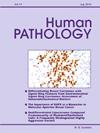胃肠道igg4相关疾病:淋巴浆细胞病、嗜酸性粒细胞增多症和肿块形成病变的罕见病因
IF 2.6
2区 医学
Q2 PATHOLOGY
引用次数: 0
摘要
igg4相关疾病(IgG4RD)是一种全身纤维炎性疾病,可累及多个器官,但很少累及小管胃肠道。我们确定了在我们机构诊断出的明确或可能的胃肠道IgG4RD患者。我们的队列包括8例患者,中位年龄为37岁(15-73岁),男性占轻微优势(63%)。病变部位包括食道(5次活检)、回肠末端(2次活检)和结肠(1次活检并切除)。2例患者出现肿块(1例结肠,1例回肠末端),1例食管狭窄。所有病例均有明显的富浆细胞浸润,伴有分散的嗜酸性粒细胞和中性粒细胞;一个亚群有不同程度的突出组织细胞(3例)和淋巴样聚集体(4例)。结肠切除标本显示浆膜下层状纤维化和闭塞性静脉炎,这些特征在活检中未被发现。所有病例每高倍视场均有50个IgG4阳性细胞,IgG4:IgG比值>40%(5例)。2例终末回肠受累患者中1例血清IgG4浓度为135mg /dL,两例患者均对类固醇治疗有反应。3例食管受累患者血清IgG4本文章由计算机程序翻译,如有差异,请以英文原文为准。
IgG4-related disease of the tubular gastrointestinal tract: A rare cause of lymphoplasmacytosis, eosinophilia, and mass-forming lesions
IgG4-related disease (IgG4RD) is a systemic fibroinflammatory condition that can affect multiple organs, but rarely involves the tubular gastrointestinal (GI) tract. We identified patients with definitive or possible IgG4RD of the GI tract diagnosed at our institution. Our cohort included 8 patients with a median age of 37 years (range 15–73) and a slight male predominance (63 %). Sites of disease included the esophagus (5 biopsies), terminal ileum (2 biopsies), and colon (1 biopsy with subsequent resection). Two patients presented with masses (1 colon, 1 terminal ileum) and 1 with an esophageal stricture. All cases featured a prominent plasma cell-rich infiltrate with scattered eosinophils and neutrophils; a subset had variably prominent histiocytes (3 cases) and lymphoid aggregates (4 cases). The colonic resection specimen demonstrated subserosal storiform fibrosis and obliterative phlebitis, features not detectable in the biopsies. All cases had >50 IgG4-positive cells per high-power field and an IgG4:IgG ratio >40 % when evaluable (5 cases). One of two patients with terminal ileal involvement had serum IgG4 >135 mg/dL, and both patients responded to steroid treatment. Three patients with esophageal involvement had serum IgG4 <135 mg/dL. We conclude that IgG4RD is a rare cause of mass-forming lesions in the terminal ileum and colon, and a possible cause of esophageal inflammation and strictures. Diagnosing IgG4RD on biopsies is challenging, as the full histologic spectrum of features is not detectable in mucosa. Lymphoplasmacytic and eosinophilic infiltration, elevated IgG4-positive cell counts by immunohistochemistry, and correlation with serum IgG4 levels and response to steroids may aid in diagnosis.
求助全文
通过发布文献求助,成功后即可免费获取论文全文。
去求助
来源期刊

Human pathology
医学-病理学
CiteScore
5.30
自引率
6.10%
发文量
206
审稿时长
21 days
期刊介绍:
Human Pathology is designed to bring information of clinicopathologic significance to human disease to the laboratory and clinical physician. It presents information drawn from morphologic and clinical laboratory studies with direct relevance to the understanding of human diseases. Papers published concern morphologic and clinicopathologic observations, reviews of diseases, analyses of problems in pathology, significant collections of case material and advances in concepts or techniques of value in the analysis and diagnosis of disease. Theoretical and experimental pathology and molecular biology pertinent to human disease are included. This critical journal is well illustrated with exceptional reproductions of photomicrographs and microscopic anatomy.
 求助内容:
求助内容: 应助结果提醒方式:
应助结果提醒方式:


